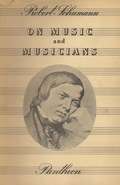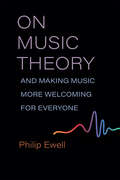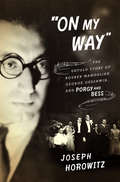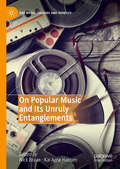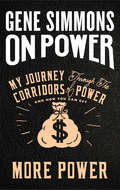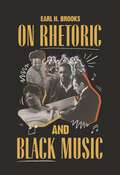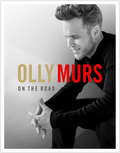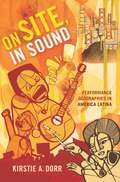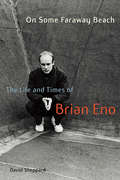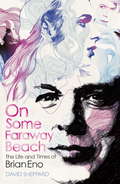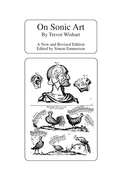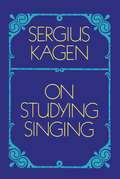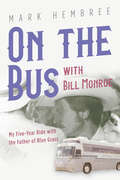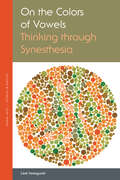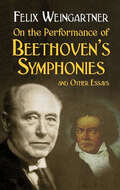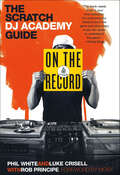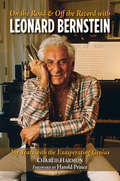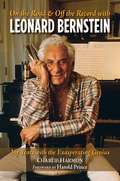- Table View
- List View
On Music and Musicians
by Robert SchumannEdited by Konraad WolffTranslated by Paul RosenfeldWith twenty black-and-white illustrationsSchumann&’s literary gifts and interests almost equaled his musical ones. From boyhood on he was drawn to literary expression, and his writings on music belong to the best among the romantic literature of the 19th century. The same fire, poetry, directness of expression, the same inventiveness we love in his compositions, also animated his prose.This edition for the first time groups his articles and observations according to subject matter and individual composers. It is complete as far as Schumann&’s writings on the great composers are concerned. All his reviews of the works by the masters, from Beethoven to Brahms, are included, some of them translated for the first time into English.
On Music Theory, and Making Music More Welcoming for Everyone (Music and Social Justice)
by Philip EwellSince its inception in the mid-twentieth century, American music theory has been framed and taught almost exclusively by white men. As a result, whiteness and maleness are woven into the fabric of the field, and BIPOC music theorists face enormous hurdles due to their racial identities. In On Music Theory, Philip Ewell brings together autobiography, music theory and history, and theory and history of race in the United States to offer a black perspective on the state of music theory and to confront the field’s white supremacist roots. Over the course of the book, Ewell undertakes a textbook analysis to unpack the mythologies of whiteness and western-ness with respect to music theory, and gives, for the first time, his perspective on the controversy surrounding the publication of volume 12 of the Journal of Schenkerian Studies. He speaks directly about the antiblackness of music theory and the antisemitism of classical music writ large and concludes by offering suggestions about how we move forward. Taking an explicitly antiracist approach to music theory, with this book Ewell begins to create a space in which those who have been marginalized in music theory can thrive.
"On My Way": The Untold Story of Rouben Mamoulian, George Gershwin, and Porgy and Bess
by Joseph HorowitzA revelatory history of the operatic masterpiece that both made and destroyed Rouben Mamoulian, its director and unsung hero. "Bring my goat!" Porgy exclaims in the final scene of Gershwin's opera Porgy and Bess. Bess, whom he loves, has left for New York City, and he's determined to find her. When his request is met with astonishment--New York is a great distance from South Carolina's Catfish Row--Porgy remains undaunted. He mounts his goat-cart and leads the community in an ecstatic finale, "Oh Lawd, I'm on my way." Stephen Sondheim has called "Bring my goat!" "one of the most moving moments in musical theater history." For years it was assumed that DuBose Heyward--the author of the seminal novella and subsequent play, Porgy, and later the librettist for the opera Porgy and Bess--penned this historic line. In fact, both it and "Oh Lawd, I'm on my way" were added to the play eight years earlier by that production's unheralded architect: Rouben Mamoulian. Porgy and Bess as we know it would not exist without the contributions of this master director. Culling new information from the recently opened Mamoulian Archives at the Library of Congress, award-winning author Joseph Horowitz shows that, more than anyone else, Mamoulian took Heyward's vignette of a regional African-American subculture and transformed it into an epic theater work, a universal parable of suffering and redemption. Part biography, part revelatory history, "On My Way" re-creates Mamoulian's visionary style on stage and screen, his collaboration with George Gershwin, and the genesis of the opera that changed the face of American musical life.
On Popular Music and Its Unruly Entanglements: Blurring The Lines (Pop Music, Culture and Identity)
by Nick Braae Kai Arne HansenOn Popular Music and Its Unruly Entanglements comprises eleven essays that explore the myriad ways in which popular music is entwined within social, cultural, musical, historical, and media networks. The authors discuss genres as diverse as mainstream pop, hip hop, classic rock, instrumental synthwave, video game music, amateur ukelele groups, and audiovisual remixes, while also considering the music’s relationship to technological developments, various media and material(itie)s, and personal and social identity. The collection presents a range of different methodologies and theoretical positions, which results in an eclecticism that aptly demonstrates the breadth of contemporary popular music research. The chapters are divided into three major sections that address: wider theoretical and analytical issues (“Broad Strokes”), familiar repertoire or concepts from a new perspective (“Second Takes”), and the meanings to arise from music’s connections with other media forms (“Audiovisual Entanglements”).
On Power: My Journey Through the Corridors of Power and How You Can Get More Power
by Gene SimmonsThe KISS frontman and entrepreneur shares his philosophy of power—how to attain it, keep it, and harness it as a driving force in business and life.As co-founder of KISS, America’s #1 gold record-winning group of all time, Gene Simmons knows the thrill and seduction of power firsthand. But gold records alone don’t equal power. The decisions you make once you attain a certain level of success are what separate the pretenders from the pantheon.Inspired by Niccolo Machiavelli’s The Prince, Simmons offers his unique take on the dynamics of power in every realm of life, from the bedroom to the boardroom, as well as the worlds of celebrity, social media, and politics. With one-of-a-kind anecdotes from his life and career, as well as stories from historical and contemporary masters of power, including Winston Churchill, Napoleon Bonaparte, Warren Buffett, Michael Jordon, Oprah, and Elon Musk, Simmons crafts a persuasive and provocative theory on how the pursuit of power drives civilization and defines our lives.The rules of power are changing in today’s fast-paced, hyper-connected world in a way that Machiavelli never could have imagined, and we all need to learn to adapt. Simmons tells readers: Ignore the negatives. Be unrelenting. Rise above the rest. You are the architect of your success.
On Purity in Musical Art
by Anton Friedrich Justus ThibautFirst published at Heidelberg in 1825 this is a study of moral purity in music, particularly church music.“The fact that this Essay was first published more than half a century ago, might seem, at first sight, to render its translation now a work of doubtful utility. But, inasmuch as it is still in demand in Germany, as is proved by the publication of the Fifth Edition as recently as in 1875, and looking to the great extension of the study and practice of music in our own country, I am persuaded that it will be read both with interest and with profit in England.”-Preface
On Rhetoric and Black Music (African American Life Series)
by Earl H. BrooksThis groundbreaking analysis examines how Black music functions as rhetoric, considering its subject not merely reflective of but central to African American public discourse. Author, musician, and scholar Earl H. Brooks argues that there would have been no Harlem Renaissance, Civil Rights Movement, or Black Arts Movement as we know these phenomena without Black music. Through rhetorical studies, archival research, and musical analysis, Brooks establishes the "sonic lexicon of Black music," defined by a distinct constellation of sonic and auditory features that bridge cultural, linguistic, and political spheres with music. Genres of Black music such as blues and jazz are discursive fields, where swinging, improvisation, call-and-response, blue notes, and other musical idioms serve as rhetorical tools to articulate the feelings, emotions, and states of mind that have shaped African American cultural and political development. Examining the resounding artistry of iconic musicians such as Scott Joplin, Mary Lou Williams, Duke Ellington, John Coltrane, and Mahalia Jackson, this work offers an alternative register in which these musicians and composers are heard as public intellectuals, consciously invested in crafting rhetorical projects they knew would influence the public sphere.
On The Road: The real stories on tour
by Olly MursWant to know what really goes on during an Olly Murs UK tour? Then get the lowdown in my new book, On The Road - the official, uncensored, up close and personal story of 2015's Never Been Better UK adventure. Packed with 200 exclusive pictures, this fly-on-the-wall release captures all the excitement and drama of a 27-gig trip around the country, including the jokes, arguments, heartbreaks and giggles, with some parties thrown in along the way. You could say it's an exclusive insight into all the hard work that goes into putting on a nationwide tour for the best fans in the world. That's not all, though. Keep your eyes peeled for several special guest appearances from the likes of Robbie Williams, Jonathan Ross and the comedians, Russell Brand and John Bishop. One or two Premier League footballers rock up in the story, and I fall victim to a few terrible practical jokes. If that's not enough, there's also the untold story of what really happened when I got the X Factor job.Planes, tourbuses and a helicopter ride or two: On The Road is the access-all-areas tale of my biggest ever headline tour. I promise it's going to give my fans a real insight into what my life's like really behind the scenes - grumps, giggles and all. Don't believe me? Just watch...
On Russian Music
by Richard TaruskinOver the past four decades, Richard Taruskin's publications have redefined the field of Russian music study. This volume gathers thirty-six essays on composers ranging from Bortnyansky in the eighteenth century to Tarnopolsky in the twenty-first, as well as all of the famous names in between. Some of these pieces, like the ones on Chaikovsky's alleged suicide and on the interpretation of Shostakovich's legacy, have won fame in their own right as decisive contributions to some of the most significant debates in contemporary musicology. An extensive introduction lays out the main issues and a justification of Taruskin's approach, seen both in the light of his intellectual development and in that of the changing intellectual environment, which has been particularly marked by the end of the cold war in Europe.
On Site, In Sound: Performance Geographies in América Latina
by Kirstie A. DorrIn On Site, In Sound Kirstie A. Dorr examines the spatiality of sound and the ways in which the sonic is bound up in perceptions and constructions of geographic space. Focusing on the hemispheric circulation of South American musical cultures, Dorr shows how sonic production and spatial formation are mutually constitutive, thereby pointing to how people can use music and sound to challenge and transform dominant conceptions and configurations of place. Whether tracing how the evolution of the Peruvian folk song "El Condor Pasa" redefined the boundaries between national/international and rural/urban, or how a pan-Latin American performance center in San Francisco provided a venue through which to challenge gentrification, Dorr highlights how South American musicians and activists created new and alternative networks of cultural exchange and geopolitical belonging throughout the hemisphere. In linking geography with musical sound, Dorr demonstrates that place is more than the location where sound is produced and circulated; it is a constructed and contested domain through which social actors exert political influence.
On Some Faraway Beach: The Life and Times of Brian Eno
by David SheppardFrom an idiosyncratic childhood in a sleepy British market town to the top of the international pop charts, this first critical examination of the life of Brian Eno charts a lengthy and colorful journey. Interviews with many key collaborators--such as David Byrne, Robert Wyatt, John Cale, Bryan Ferry, and Gavin Bryars--along with input from Brian and his wife, Anthea, illuminate the man and his ideas and how he retained an edge and maintained independence. This sonic alchemist to the stars has contributed to the most challenging and critically revered work of Roxy Music, David Bowie, Talking Heads, Devo, U2, and Coldplay, and few collections remain untouched by his distinctive aesthetic.
On Some Faraway Beach: The Life and Times of Brian Eno
by David SheppardAuthorised biography of Brian Eno - the 'Father of Ambient Music'A sonic alchemist to the stars, Brian Eno's address book is a veritable who's who of rock and pop. Tellingly, his involvement with Roxy Music, David Bowie, Talking Heads and U2 has coincided with these artists producing their most challenging and critically revered work.ON SOME FARAWAY BEACH is the first serious, critical examination of the life and times of Brian Eno, from an idiosyncratic childhood to 1960s art school and the sharp end of pop charts around the world.
On Some Faraway Beach: The Life and Times of Brian Eno
by David SheppardAuthorised biography of Brian Eno - the 'Father of Ambient Music'A sonic alchemist to the stars, Brian Eno's address book is a veritable who's who of rock and pop. Tellingly, his involvement with Roxy Music, David Bowie, Talking Heads and U2 has coincided with these artists producing their most challenging and critically revered work.ON SOME FARAWAY BEACH is the first serious, critical examination of the life and times of Brian Eno, from an idiosyncratic childhood to 1960s art school and the sharp end of pop charts around the world.
On Some Faraway Beach: The Life and Times of Brian Eno (Deep Cuts)
by David SheppardFOREWORD BY ALAN WARNER'A book that sets new standards for rock biography' GuardianReissued as part of White Rabbit's Deep Cuts series, On Some Faraway Beach is the first and only ever comprehensive and authoritative biography of Brian Eno, featuring interviews with many of his key collaborators over the years: from Bryan Ferry to David Byrne and Robert Wyatt. First published in 2008, it has been fully revised and updated to cover Eno's life and creative output since, with brand new material and a new introduction by Alan Warner.'This exceptionally well-written biography duly celebrated [Eno's] great achievements with Roxy, Bowie, Talking Heads and his own solo work in compelling detail' Uncut'[An] honourable, authorised attempt to do justice to a mind-bogglingly restless and prolific subject' Sunday Times
On Some Faraway Beach: The Life and Times of Brian Eno (Deep Cuts)
by David SheppardFOREWORD BY ALAN WARNER'A book that sets new standards for rock biography' GuardianReissued as part of White Rabbit's Deep Cuts series, On Some Faraway Beach is the first and only ever comprehensive and authoritative biography of Brian Eno, featuring interviews with many of his key collaborators over the years: from Bryan Ferry to David Byrne and Robert Wyatt. First published in 2008, it has been fully revised and updated to cover Eno's life and creative output since, with brand new material and a new introduction by Alan Warner.'This exceptionally well-written biography duly celebrated [Eno's] great achievements with Roxy, Bowie, Talking Heads and his own solo work in compelling detail' Uncut'[An] honourable, authorised attempt to do justice to a mind-bogglingly restless and prolific subject' Sunday Times
On Sonic Art (Contemporary Music Studies #Vol. 12.)
by Trevor WishartIn this newly revised book On Sonic Art, Trevor Wishart takes a wide-ranging look at the new developments in music-making and musical aesthetics made possible by the advent of the computer and digital information processing. His emphasis is on musical rather than technical matters. Beginning with a critical analysis of the assumptions underlying the Western musical tradition and the traditional acoustic theories of Pythagoras and Helmholtz, he goes on to look in detail at such topics as the musical organization of complex sound-objects, using and manipulating representational sounds and the various dimensions of human and non-human utterance. In so doing, he seeks to learn lessons from areas (poetry and sound-poetry, film, sound effects and animal communication) not traditionally associated with the field of music.
On Studying Singing (Dover Books On Music: Voice)
by Sergius Kagen"Logical, clear, convincing, and, in my modest judgment, dead right." -- Virgil Thomson, New York Herald Tribune"I recommend this volume highly." -- Maggie Teyte, Saturday Review"One of the most sensible books on the subject of vocal art." -- Felix Borowski, Chicago Sun-TimesThis book is an invaluable guide for the student, parent, teacher, coach, or any person connected with vocalism. It is not intended to teach the student how to sing since no book could possibly do this. Its main purpose is to help him find a way to study singing intelligently.The author, who is a member of the faculty of the Juilliard School of Music and a prominent musician with a vast experience of teaching singers, explains in this book clearly and logically just what a student can and cannot expect from singing lessons. He also discusses in detail the various subsidiary studies necessary to the singer, such as the study of musical notation and theory, ear training, languages, and other allied subjects.Particularly useful and interesting is the section dealing with various methods employed in teaching vocal technique. In this section, Mr. Kagen debunks the so-called "scientific methods" of voice teaching and the concept of "building voices" -- follies which have often led to an enormous waste of money, time, and effort.
On the Bus with Bill Monroe: My Five-Year Ride with the Father of Blue Grass (Music in American Life)
by Mark HembreeA backstage audition led Mark Hembree into a five-year stint (1979–1984) as the bassist for Bill Monroe's Blue Grass Boys. Hembree’s journey included playing at the White House and on the acclaimed album Master of Bluegrass. But it also put him on a collision course with the rigors of touring, the mysteries of Southern culture, and the complex personality of bandleader-legend Bill Monroe. Whether it’s figuring out the best time for breakfast (early) or for beating the boss at poker (never), Hembree gives readers an up-close look at the occasionally exalting, often unglamorous life of a touring musician in the sometimes baffling, always colorful company of a bluegrass icon. The amusing story of a Yankee fish out of water, On the Bus with Bill Monroe mixes memoir with storytelling to recount the adventures of a Northerner learning new ways and the Old South.
On the Colors of Vowels: Thinking through Synesthesia (Verbal Arts: Studies in Poetics)
by Liesl YamaguchiTreatments of synesthesia in the arts and humanities generally assume a clear distinction between the neurological condition and the literary device. Synesthetes’ descriptions of colors seen in connection with music, for example, are thought to differ fundamentally from common expressions that rely on transpositions across sensory dimensions (“bright vowels”). This has not always been the case. The distinction emerged over the course of the twentieth century, as scientists sought to constitute “synesthesia” as a legitimate object of modern science.On the Colors of Vowels investigates the ambiguity of visual descriptions of vowels across a wide range of disciplines, casting several landmark texts in a wholly new light. The book traces the migration of sound-color correspondence from its ancient host (music) to its modern one (vowels), investigating the vocalic Klangfarben of Hermann von Helmholtz’s monumental Sensations of Tone, the vowel colors reported in early psychology surveys into audition colorée (colored hearing), the mis-matched timbres that form poetry’s condition of possibility in Stéphane Mallarmé’s “Crisis of Verse,” and the vowel-color analogy central to both the universal alphabets of the nineteenth century and the phonological universals of the twentieth. The book’s final chapter turns to an intricately detailed account of vowel-color correspondence by Ferdinand de Saussure, suggesting how the linguist’s sensitivity to vowel coloration may have guided his groundbreaking study of Indo-European vocalism.Bringing out the diverse ways in which visual conceptions of vowels have inflected the arts and sciences of modernity, On the Colors of Vowels makes it possible to see how discourses of the nineteenth and twentieth centuries crafted the enigma we now readily recognize as “synesthesia.”
On the Origin and Progress of the Art of Music by John Taverner (Music Theory in Britain, 1500–1700: Critical Editions)
by Joseph M. OrtizJohn Taverner’s lectures on music constitute the only extant version of a complete university course in music in early modern England. Originally composed in 1611 in both English and Latin, they were delivered at Gresham College in London between 1611 and 1638, and it is likely that Taverner intended at some point to publish the lectures in the form of a music treatise. The lectures, which Taverner collectively titled De Ortu et Progressu Artis Musicæ ("On the Origin and Progress of the Art of Music"), represent a clear attempt to ground musical education in humanist study, particularly in Latin and Greek philology. Taverner’s reliance on classical and humanist writers attests to the durability of music’s association with rhetoric and philology, an approach to music that is too often assigned to early Tudor England. Taverner is also a noteworthy player in the seventeenth-century Protestant debates over music, explicitly defending music against Reformist polemicists who see music as an overly sensuous activity. In this first published edition of Taverner’s musical writings, Joseph M. Ortiz comprehensively introduces, edits, and annotates the text of the lectures, and an appendix contains the existing Latin version of Taverner’s text. By shedding light on a neglected figure in English Renaissance music history, this edition is a significant contribution to the study of musical thought in Renaissance England, humanism, Protestant Reformism, and the history of education.
On the Performance of Beethoven's Symphonies and Other Essays (Dover Books On Music: Analysis)
by Felix WeingartnerThis volume contains English translations of three important literary works by Austrian conductor Felix Weingartner (1863-1942). The title essay is a detailed account of specific performing difficulties and questions of interpretation in each of the nine symphonies, a comprehensive treatment that will be indispensable to music students. Additional features include "On Conducting" and "The Symphony Since Beethoven," both of which attest to the author's belief that art is at its best when an "exceedingly delicate balance is attained between the feeling and the intellect." Weingartner's wealth of observations on music and musicians will fascinate anyone interested in symphonic traditions.
On the Record: The Scratch DJ Academy Guide
by Phil White Luke Crisell Rob PrincipeIn the three decades since Kool Herc first put the same record on two side-by-side turntables, DJs have moved out of city parks, house and block parties, and the darkened booths of nightclubs, and onto center stage, performing before admiring crowds of thousands. They have not only given rise to hip-hop and house—DJs have influenced fashion, film, TV, and more. With On the Record, Scratch DJ Academy, the premiere institution for DJ education, brings together years of training and expertise to create an authoritative guide to the dynamic art of DJing. More than just a "how-to," this is a sonic adventure, guiding you through forty years of music, creativity, and culture. From beat matching to body tricks, Grandmaster Flash to Fatboy Slim, the Bronx to Ibiza, On the Record is an all-in-one guide. So whether you're learning the ropes, considering going pro, or just want insight into a broader range of music, this book is for you.
On the Road (Disney's Hannah Montana #14)
by Kitty RichardsSeries Description: Miley Stewart looks like a regular girl-next-door, but when the lights go down, Miley is teen pop sensation Hannah Montana! Off stage, Miley wants her life to be as normal as possible, so only a few people know the truth about her dual identity. But keeping that secret is harder than Miley ever thought it would be. Hannah Montana #14: On the Road. Miley is totally disappointed! Her dad canceled Hannah Montana's European concert tour because she is flunking biology. But if she can ace her midterm, Hannah's tour is back on! Miley is determined to go to Europe, so she creates song and dance routines as study techniques for the test. Will Miley's preparations earn her an A, or will she be left singing the blues? Plus, when Miley's dad forbids her to travel alone for a Hannah Montana charity concert, she decides to take matters into her own hands-and goes anyway!
On the Road and Off the Record with Leonard Bernstein: My Years with the Exasperating Genius
by Charlie HarmonCelebrating Leonard Bernstein's centenary with an intimate and detailed look at the public and private life of the Maestro written by his former assistant. Foreword by Broadway legend Harold Prince."An affectionate portrait of an eminent musician who was driven by demons." —Kirkus Reviews "Harmon’s personable and warm account of what it was like to work for one of the twentieth century’s musical giants casts new light on Bernstein and his world." —Booklist "This multifaceted perspective gives readers plenty of salacious gossip paired with insight into Leonard Bernstein’s remarkable artistic achievements later in life." —Library Journal On the Road is a colorfully written, unforgettably entertaining and unputdownable book, and is available just in time for LB’s 100th birthday. Unreservedly recommended. —Fanfare Magazine Leonard Bernstein reeked of cheap cologne and obviously hadn't showered, shaved, or slept in a while. Was he drunk to boot? He greeted his new assistant with "What are you drinking?" Yes, he was drunk. Charlie Harmon was hired to manage the day-to-day parts of Bernstein's life. There was one additional responsibility: make sure Bernstein met the deadline for an opera commission. But things kept getting in the way: the centenary of Igor Stravinsky, intestinal parasites picked up in Mexico, teaching all summer in Los Angeles, a baker's dozen of young men, plus depression, exhaustion, insomnia, and cut-throat games of anagrams. Did the opera get written?For four years, Charlie saw Bernstein every day, as his social director, gatekeeper, valet, music copyist, and itinerant orchestra librarian. He packed (and unpacked) Bernstein's umpteen pieces of luggage, got the Maestro to his concerts, kept him occupied changing planes in Zurich, Anchorage, Tokyo, or Madrid, and learned how to make small talk with mayors, ambassadors, a chancellor, a queen, and a Hollywood legend or two. How could anyone absorb all those people and places? Because there was music: late-night piano duets, or the Maestro's command to accompany an audition, or, by the way, the greatest orchestras in the world. Charlie did it, and this is what it was like, told for the first time.
On the Road and Off the Record with Leonard Bernstein: My Years with the Exasperating Genius
by Charlie Harmon Harold Hal" PrinceA celebratory, intimate, and detailed look at the public and private life of Leonard Bernstein written by his former assistant. Foreword by Broadway legend Harold Prince.Leonard Bernstein reeked of cheap cologne and obviously hadn't showered, shaved, or slept in a while. Was he drunk to boot? He greeted his new assistant with "What are you drinking?" Yes, he was drunk.Charlie Harmon was hired to manage the day-to-day parts of Bernstein's life. There was one additional responsibility: make sure Bernstein met the deadline for an opera commission. But things kept getting in the way: the centenary of Igor Stravinsky, intestinal parasites picked up in Mexico, teaching all summer in Los Angeles, a baker's dozen of young men, plus depression, exhaustion, insomnia, and cut-throat games of anagrams. Did the opera get written?For four years, Charlie saw Bernstein every day, as his social director, gatekeeper, valet, music copyist, and itinerant orchestra librarian. He packed (and unpacked) Bernstein's umpteen pieces of luggage, got the Maestro to his concerts, kept him occupied changing planes in Zurich, Anchorage, Tokyo, or Madrid, and learned how to make small talk with mayors, ambassadors, a chancellor, a queen, and a Hollywood legend or two. How could anyone absorb all those people and places? Because there was music: late-night piano duets, or the Maestro's command to accompany an audition, or, by the way, the greatest orchestras in the world. Charlie did it, and this is what it was like, told for the first time.
